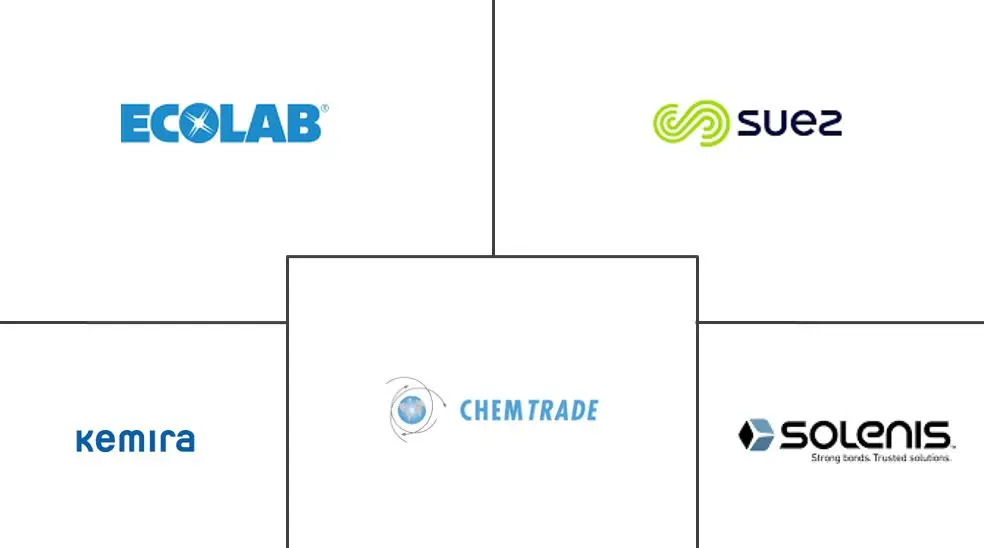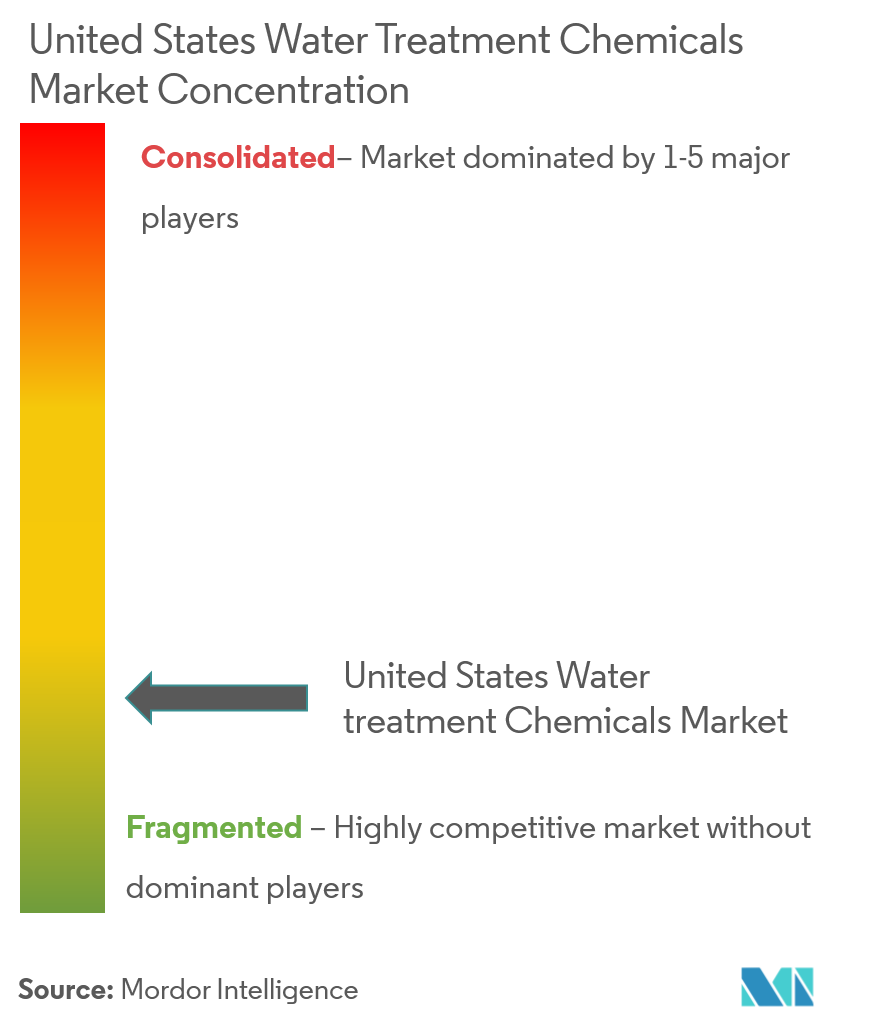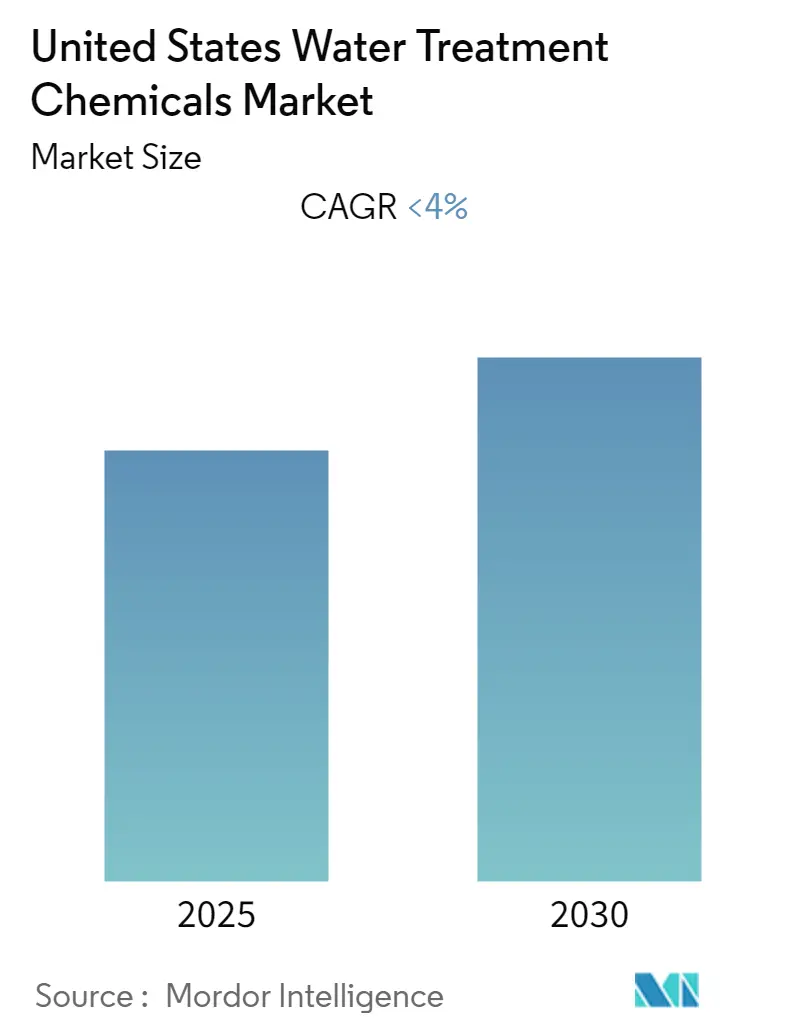
US Water Treatment Chemicals Market Analysis
The United States Water Treatment Chemicals Market is expected to register a CAGR of less than 4% during the forecast period.
- On the flipside, the impact of the COVID-19 pandemic is expected to hinder the growth of the market.
- The increasing focus on treating emerging contaminants is providing opportunities for the market during the forecast period.
- Among the end-user industries, the municipal industry accounts for the major market share and is likely to maintain its position during the forecast period.
US Water Treatment Chemicals Market Trends
Corrosion and Scale Inhibitors to Dominate the market
- Corrosion inhibitors are general purpose chemicals applied to deal with corrosion caused in boilers. Corrosion occurs due to the reaction of oxygen with metallic parts in a boiler to form oxides. Corrosion affects the metallic part of the boiler, thereby, increasing the cost of energy and maintenance. Corrosion inhibitors act by forming a thin layer of barrier over the exposed parts of the boiler from the water.
- Several types of corrosion inhibitors are used in water boilers. These include condensate line corrosion inhibitor, DEHA - diethyl hydroxyl amine, polyamine, morpholine, cyclohexylamine, and carbon dioxide corrosion inhibitor. A mixture of filming amines is used to prepare a condensate line corrosion inhibitors. This can provide protection in every stage, due to the presence of both high and low vapor/liquids.
- DEHA is a volatile compound, which is also an oxygen scavenger and acts as a metal passivating agent. Polyamine can be used in both low pressure and high-pressure boilers. Morpholine protects the boiler by increasing the pH level of the liquid. Cyclohexylamine is used in low pressure boilers. Carbon dioxide corrosion inhibitor is used, along with polyamine, to control the corrosion.
- These inhibitors are also used in cooling water treatment to ensure metal protection and prevent metal loss, which may lead to critical system failures in recirculating water piping, process cooling equipment, and heat exchangers. Corrosion inhibitors are added to the treatment systems to protect the metals, by reducing the corrosion potential associated with cathode and anode of the corrosion cell.
- The most serious form of corrosion occurs in cooling water treatment systems, which contain both steel and copper alloys.
- Scale is a precipitate that is formed on the surface of water treatment towers as a result of the precipitation of soluble solids, which become insoluble as the temperature increases. This, in turn, causes metallic corrosion that affects the functioning and maintenance of cooling water towers. This deposition increases corrosion rates, causes loss of production, restricts water flow, and interferes with heat transfer.
- As a result, to safeguard open and closed cooling systems and maintain their efficiency, accurate water conditions need to be maintained, which can be achieved by adding scientifically designed chemicals that act as scale inhibitors.
- In the boiler water treatment, if the untreated water is used in the boiler, it brings with it a number of soluble salts. Though these remain soluble in cold water, they become insoluble with the rise in temperature inside the boiler.
- Carbonates and bicarbonates are formed from calcium and magnesium chemicals that are dissolved in water. This residue matter gets deposited in the boiler surface and forms a hard coating, which is known as scale. The problem with the scales is that they block efficient heat transfer, create localized heating, increase power consumption and maintenance expense and, at times, even boiler failure.
- Scale inhibitors are used to remove scales through chemical action. These can be broadly grouped into three types, namely, phosphates, polymers, and chelants.
- Phosphates are used to remove the hydroxyapatite and serpentine compounds of calcium and magnesium, which create the hard scales. Phosphates, along with polymers, are used to create a sludge, which is used to remove the scales by boiler blowdown.
- Polymers or polyelectrolytes can be used in boilers, either alone, or combined with phosphates or chelants. Polymers act as dispersants and weak sequestrants of hard scale materials. However, it is not possible to completely remove deposits from boilers with a limited blowdown. Chelation depends upon the chemical binding action of calcium, magnesium, and iron, and keeping them soluble. Chelation is costlier than phosphate treatment.
- Chelants are used mostly in boiler feed water than inside boiler. The use of chelant is advisable when several minimum requirements regarding liquid composition are satisfied.
- Majority of the demand for scale inhibitors comes from the oil and gas and petrochemical industry. The oil and gas industry of the United States is currently witnessing repercussion of COVID-19 outbreak affecting production in 2020, also creating negative impact on the demand for scale inhibitors.
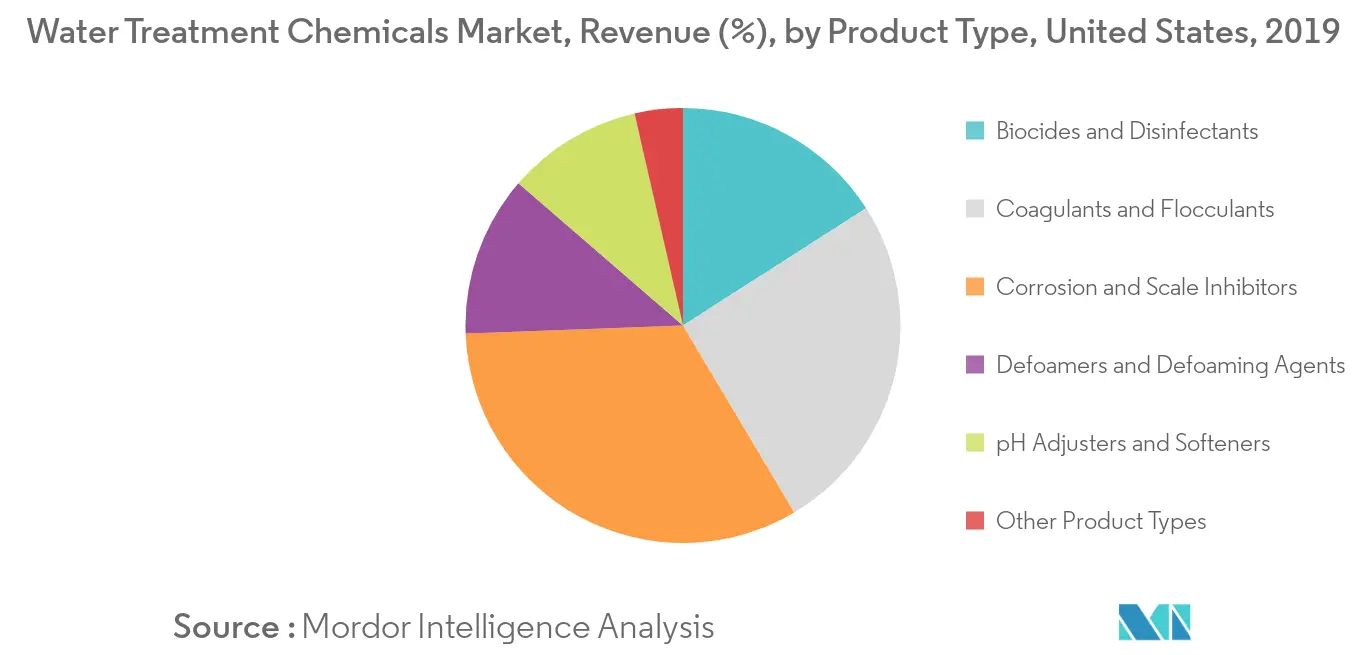
Municipal Industry to Drive the Market Demand
- The supply of pure water to the households is one of the chief requirements for all the governments. The rising scarcity of potable water, coupled with the growing population and increasing water demand, is the major concern that is driving the demand for the membrane water treatment chemicals market, worldwide.
- A huge increase in usage of Reserve Osmosis (RO) systems to obtain potable water has led to the rapid rise in the usage of membrane water treatment chemicals, like antiscalants, etc.
- Municipal wastewater refers to the water that drains from toilets, showers, sinks, bathrooms, washing machines, dishwashers, and liquid industrial waste. Municipal wastewater should be treated before releasing it into the environment, to avoid damage to the environment and the spreading of harmful diseases.
- The major applications of treatment technologies include preliminary treatment, primary and secondary treatment, tertiary treatment, biological nutrient removal (BNR), resource recovery, energy generation, etc.
- In the United States, wastewater treatment facilities process about 34 billion gallons of wastewater every day. This adds significant demand for water treatment chemicals from the municipal sector in the country.
- Moreover, water scarcity has been increasing dependency on wastewater treatment facilities which is likely to further create opportunities for water treatment chemicals in the country in the coming years.
- For instance, in the city of Monterey, California; a large agricultural area requires almost 80,000 m3 of water per day, for which nutrient-rich reclaimed municipal wastewater is supplied to irrigate and fertilize crops.
- During lockdown, water usage of the household indicated an increase of about 21% in the country. In April 2020, the average household used nearly 729 additional gallons of water in April as compared to that in February 2020. Hence, this indicates increased requirement for water treatment.
- Besides, in July 2020, the Environmental Protection Agency (EPA) announced an investment on critical water infrastructure of about USD 6 billion to support USD 12 billion in water infrastructure projects under Water Infrastructure Finance and Innovation Act (WIFIA) program. Hence, with such developments, the need for water treatment chemicals is also expected to increase in the coming years.
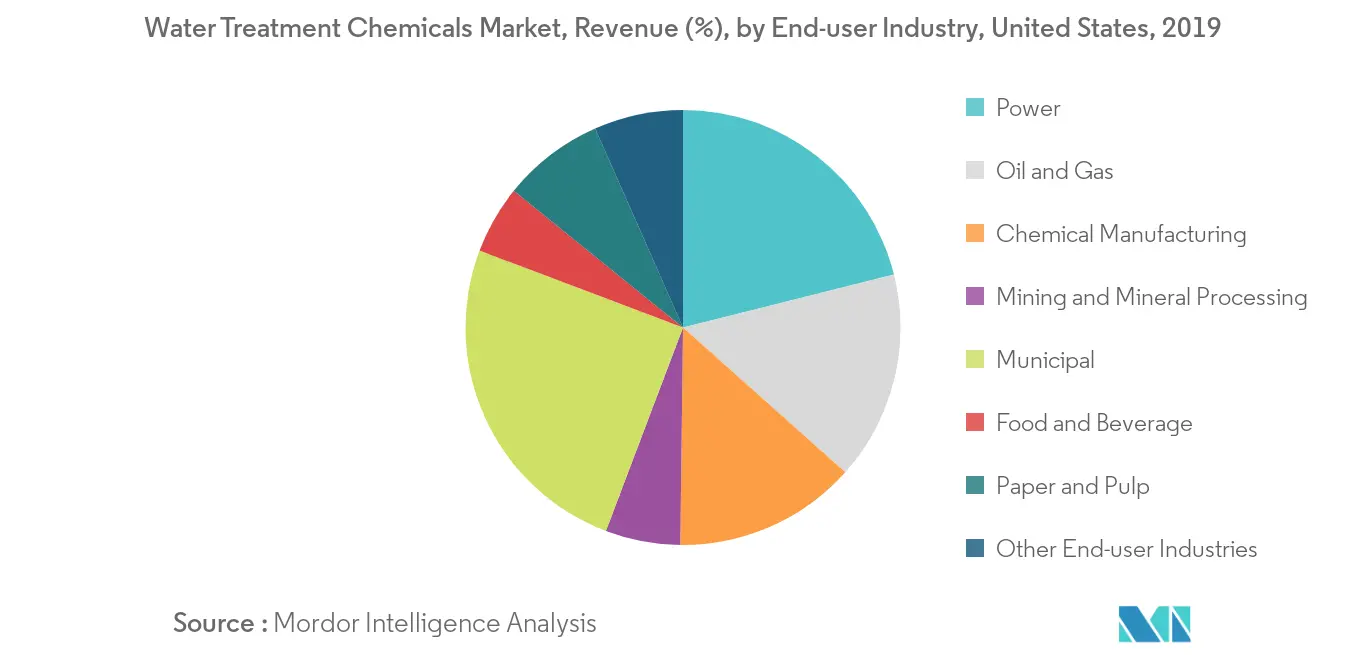
US Water Treatment Chemicals Industry Overview
The United States water treatment chemicals market is fragmented in nature with the top five players accounting for less than 30% of the overall market share. Key players in the market studied include Ecolab, Solenis, Chemtrade, SUEZ, and Kemira, among others.
US Water Treatment Chemicals Market Leaders
-
Ecolab
-
Kemira
-
Suez
-
Solenis
-
Chemtrade
- *Disclaimer: Major Players sorted in no particular order
US Water Treatment Chemicals Industry Segmentation
The United States water treatment chemicals market includes:
| Product Type | Biocides and Disinfectants |
| Coagulants and Flocculants | |
| Corrosion and Scale Inhibitors | |
| Defoamers and Defoaming Agents | |
| pH & Adjusters and Softeners | |
| Other Product Types | |
| End-user Industry | Power |
| Oil and Gas | |
| Chemical Manufacturing | |
| Mining and Mineral Processing | |
| Municipal | |
| Food and Beverage | |
| Pulp and Paper | |
| Other End-user Industries |
US Water Treatment Chemicals Market Research FAQs
What is the current United States Water Treatment Chemicals Market size?
The United States Water Treatment Chemicals Market is projected to register a CAGR of less than 4% during the forecast period (2025-2030)
Who are the key players in United States Water Treatment Chemicals Market?
Ecolab, Kemira, Suez, Solenis and Chemtrade are the major companies operating in the United States Water Treatment Chemicals Market.
What years does this United States Water Treatment Chemicals Market cover?
The report covers the United States Water Treatment Chemicals Market historical market size for years: 2019, 2020, 2021, 2022, 2023 and 2024. The report also forecasts the United States Water Treatment Chemicals Market size for years: 2025, 2026, 2027, 2028, 2029 and 2030.
Our Best Selling Reports
US Water Treatment Chemicals Industry Report
Statistics for the 2025 United States Water Treatment Chemicals market share, size and revenue growth rate, created by Mordor Intelligence™ Industry Reports. United States Water Treatment Chemicals analysis includes a market forecast outlook for 2025 to 2030 and historical overview. Get a sample of this industry analysis as a free report PDF download.

